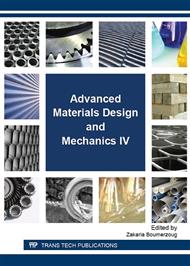[1]
T. A. Stolarski, Rolling Contact Fatigue of Polymers and Polymer Composites, Advanced in Composite Tribology edited by K. Friedrich, Elservier, 1993, Chapter 17.
DOI: 10.1016/b978-0-444-89079-5.50021-0
Google Scholar
[2]
K. Friedrich, G. Theiler and P. Klein, Polymer composites for tribological applications in a range between liquid helium and room temperature, In: SinhaSK, BriscoeBJ, editors. Polymer Tribology, London UK: Imperial College Press, (2009).
DOI: 10.1142/9781848162044_0011
Google Scholar
[3]
K. Friedrich, Z. Lu and A. M. Hager, Overview on polymer composites for friction and wear application, Theoretical and Applied Fracture Mechanics, 19, (1993), 1-11.
DOI: 10.1016/0167-8442(93)90029-b
Google Scholar
[4]
M. Harrass, K. Friedrich, A. A. Almajid, Tribological behavior of selected engineering polymers under rolling contact, Tribology International, 43, (2010), 635-646.
DOI: 10.1016/j.triboint.2009.10.003
Google Scholar
[5]
DearnKD, KukurekaSN, WaltonD., Engineering polymers and composites for machine elements. In: SinhaSK, BriscoeBJ, editors. Polymer Tribology. London UK: Imperial College Press; (2009), 470-505 [Chapter 14].
Google Scholar
[6]
H. Koike, T. Honda, K. Kida, E.C. Santos, J. Rozwadowska, K. Houri, M. Uryu, Y. Kashima, K. Kanemasu, Influence of radial load on PEEK plastic bearings life cycle under water lubricated conditions, Advanced Materials Research, 217-218, (2011).
DOI: 10.4028/www.scientific.net/amr.217-218.1260
Google Scholar
[7]
H. Koike, K. Kida, E. C. Santos, J. Rozwadowska, Y. Kashima and K. Kanemasu, Tribology International, 49, (2012), 30-38.
DOI: 10.1016/j.triboint.2011.12.005
Google Scholar
[8]
H. Koike, K. Kida, T. Honda, K. Mizobe, S. Oyama, J. Rozwadowska, Y. Kashima, K. Kanemasu, Observation of crack propagation in PEEK polymer bearings under water- lubricated conditions, Advanced Materials Research, 566, (2012), 109-114.
DOI: 10.4028/www.scientific.net/amr.566.109
Google Scholar
[9]
J. Rozwadowska, K. Kida, E. C. Santos, T. Honda, H. Koike, K. Kanemasu, Investigation of crack initiation and propagation during rolling contact fatigue of SUJ2 steel bearings using a newly developed one-point testing machine, Advanced Materials Research, 418-420, (2012).
DOI: 10.4028/www.scientific.net/amr.418-420.1613
Google Scholar
[10]
H. Hertz, Über die Berührung fester elastischer Körper, Journal für die reine und angewandte Mathematik, 92, (1881), 156-171.
DOI: 10.1515/9783112342404-004
Google Scholar


